Black currant varieties
Content:
In our country, perhaps, it is impossible to find a single household farm in which black currants are not grown. This berry is one of the most popular horticultural crops among Russian summer residents. It does not require excessive care, less than other types of currants are affected by various kinds of diseases and pests, and occupies not too large areas. But the benefits of this berry are truly unique, it is a source of vitamins and minerals, and in particular black currant is rich in vitamin C, so necessary to support our immunity. It is consumed fresh, compotes are prepared, and also harvested for the winter: they boil jams, grind with sugar and simply freeze. Therefore, if this wonderful berry is not yet growing on your site, or you are looking for the most delicious and high-yielding varieties of black currant, this article will be useful to you. In it we will describe the 15 most popular varieties of currants for various climatic zones of our vast country.
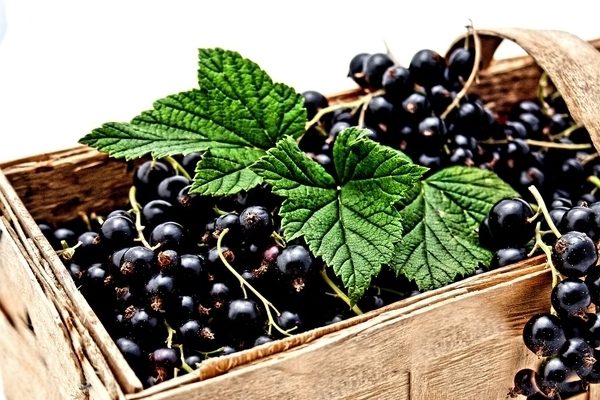
A bit of history
The first mentions of black currants can be found back in the 15th century, and the well-known Moscow River in ancient times bore the name of Smorodinovka, because many currant bushes grew along its banks.
But to cultivate black currant in our country became not so long ago, approximately in the 40s of the twentieth century. The very first variety was bred in 1947 and was called "Primorsky Champion". Since then, this variety can be found in almost every farm, although modern selection includes more than 180 varieties of this shrub. We will describe in more detail 15 the most interesting ones.
"Green Haze"
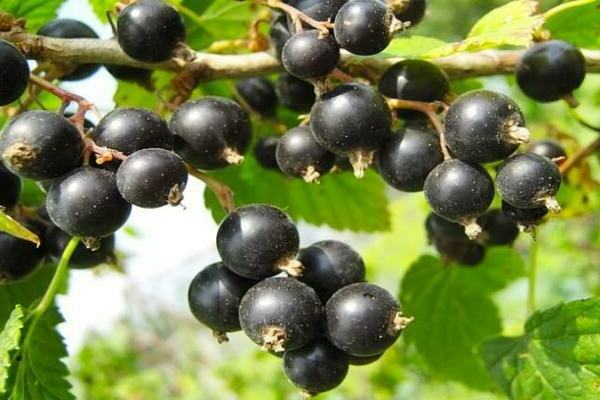
Mid-season, self-fertile, black currant variety Harmony, with the simultaneous ripening of berries, a wide range of uses. Brought to VNIIS them. Michurin. Suitable for growing in the North-West, Central, Volga-Vyatka, North Caucasian, Ural, West Siberian and East Siberian regions of Russia.
The mass of berries harvested from one plant is 3.7 kg (more than 105 kg / ha), the berries are slightly elongated, dark, glossy, the density of the skin is medium, they are plucked dry. The weight of each copy is up to 2.5 g. Each brush usually contains about 6 berries. The berries have an excellent taste, with a slight hint of nutmeg. Berries tend to crack with excess rainfall.
The bush itself is compact, slightly spreading, the stems grow vertically. The leaves are large, light green.
A representative of a highly resistant variety of currants to high and low temperature conditions, as well as to diseases such as powdery mildew and anthracnose.
"Harmony"
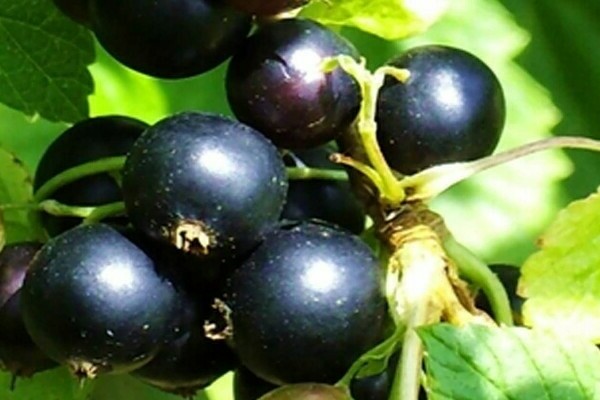
Late-ripening, self-fertile, universal variety, bred by FGBNU Scientific Research Institute of Horticulture of Siberia named after M.A. Lisavenko. Recommended for growing in the West Siberian region of Russia.
The mass of berries harvested from one plant of the variety is 3.1 kg (more than 85 c / ha), the berries are round, dark, glossy, ripen together. The density of the skin is medium, the berries are torn off dry. The weight of one piece is up to 2.2 g. There can be up to 6 of them on one brush. The taste characteristics of the berries are good, they crack with excessive precipitation.
The bush is compact, slightly spreading. The stems are vertical and slightly curved. The leaves are not large, have a light green color.
The variety is resistant to low and high temperature conditions, as well as to powdery mildew and anthracnose.
"Summer resident"
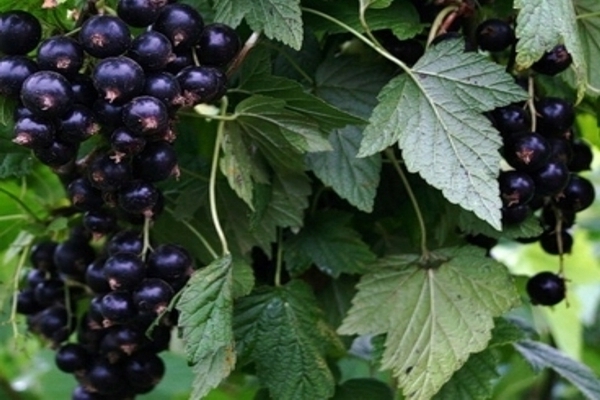
Mid-season grade Dachnitsa has a wide range of uses.Originator - FGBNU All-Russian Research Institute of Breeding of Fruit Crops. Recommendations for the area of growth - Volgo-Vyatka region.
The mass of berries harvested from one plant is 3.3 kg (more than 89 c / ha), the berries are slightly elongated, dark, almost black in color. On a short bunch, there are usually up to 7 berries, the weight of one specimen is up to 2.3 g maximum. Good taste characteristics.
The bush is compact, slightly spreading. Shoots grow vertically, leaves are not large, green.
The variety is resistant to negative temperatures, lack of moisture, as well as the incidence of powdery mildew and anthracnose-medium.
"Sensei"
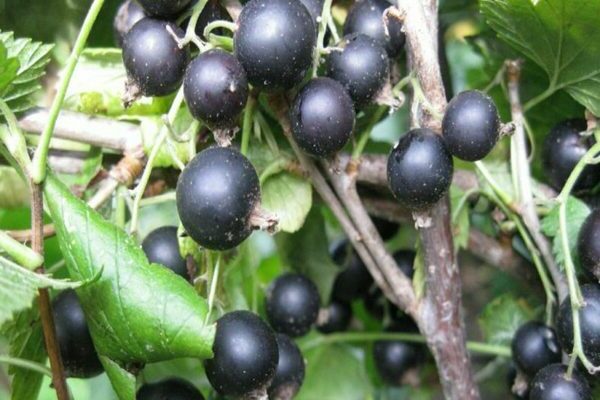
A medium early variety with a wide range of uses. Withdrawn by FGBNU FNTS them. Michurin. Suitable for cultivation in the Central region of our country.
The mass of berries harvested from one plant is 2.7 kg (more than 60 c / ha), the berries are round, black, the skin is of medium density. On a long brush, there are up to 7 pieces, the weight of one copy is up to 1.7 g. Taste characteristics are good, there is a little acid.
The bush is small, slightly spreading, stems are large in diameter, growing vertically. The leaves are large, light green.
A representative of a highly resistant variety of currants to low and high air temperatures, as well as to diseases such as powdery mildew and anthracnose.
"Pchelkinskaya"
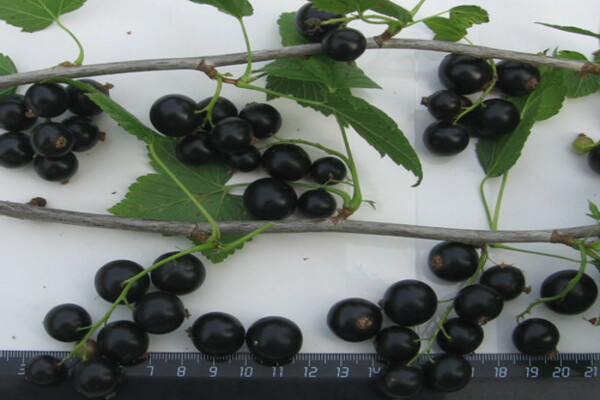
One of the earliest varieties for universal use. FGUP Bakcharskoe was developed, recommendations for the growing area - West Siberian region.
The mass of berries harvested from one plant is 2 kg (more than 40 c / ha), the years are round, black, glossy, the thickness of the skin is average. There are up to 6 berries on a medium-sized tassel, the weight of one specimen is up to 1.6 g. Taste characteristics are good, has a cooling taste.
The bush is tall, spreading, stems of medium diameter, arranged vertically. The leaves are not large, have a light shade of green.
The variety is highly resistant to low temperature conditions and moderately resistant to lack of watering, as well as powdery mildew and anthracnose.
"Agatha"
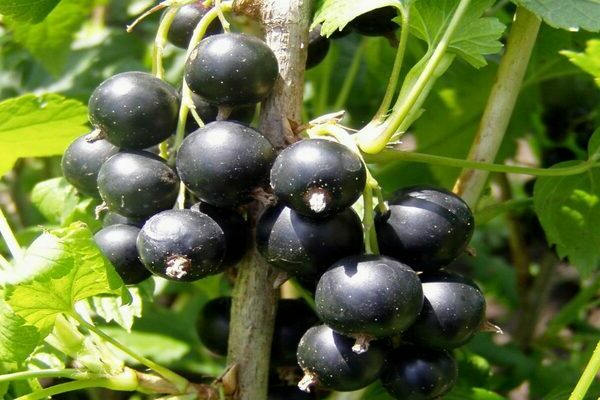
Medium early variety for a wide range of uses. Bred by FGBNU NIIS Siberia named after V.I. Lisavenko. Accordingly, this variety is most suitable for growing in the West Siberian region.
The mass of berries harvested from one plant reaches 3.8 kg (more than 106 c / ha), the berries are round, the color is black. Berries on one brush-6, the weight of one copy is up to 1.8 g. The berries have good taste characteristics, they have a strong aroma. The harvest of this variety can be transported without loss.
The bush is small but rapidly growing. Shoots of medium diameter, growing vertically. The size of the leaves is large, light shade of green.
The variety has high resistance to negative air temperatures and lack of moisture, and resistance to septoria and anthracnose is assessed as medium.
"Litvinovskaya"
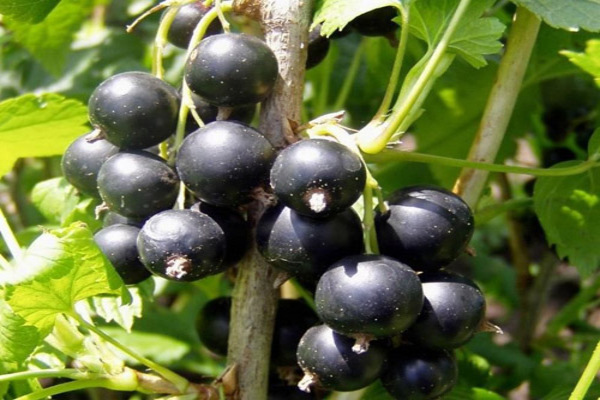
An early, self-fertile variety for universal use. Bred by FSBSI All-Russian Scientific Research Institute of Lupine, recommendations for the place of cultivation - the Central part of Russia.
The mass of berries harvested from one plant is 2.9 kg (more than 50 c / ha), the berries are round, black, the density of the skin is average. Berries on a medium-sized brush - up to 7 pieces, the weight of each specimen reaches 3.3 g. The berries taste excellent, sweet, with a strong aroma.
The bush is tall, slightly spreading, shoots of medium diameter, growing vertically. Leaves are not large, light shade of green.
This variety is resistant to low air temperatures, but has an average resistance to lack of moisture, as well as to powdery mildew and anthracnose. More about the variety here.
"Selechenskaya 2"
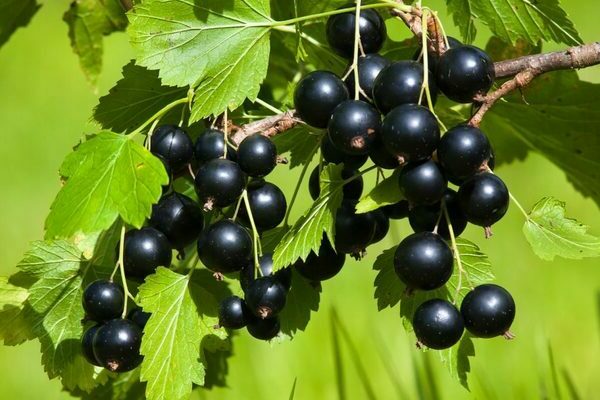
Early, self-fertile, versatile variety Selechenskaya 2... Bred by FSBSI All-Russian Scientific Research Institute of Lupine. The variety grows well in the North-West, Central, West Siberian and East Siberian regions.
The harvest can reach 3.7 kg per bush (more than 105 kg / ha), the berries are round, dark, almost black, glossy.On one brush, there are 6-7 of them, the weight of one copy is up to 2.9g. The taste of the berries is excellent, sweet, with a bright aroma.
The bush is tall, but not spreading, the stems are vertical. The leaves are not large, they have a dark shade of green.
A representative of a highly resistant currant variety to negative temperatures (except for flowering time) and lack of moisture, moderately resistant to powdery mildew and anthracnose.
"Sophia"
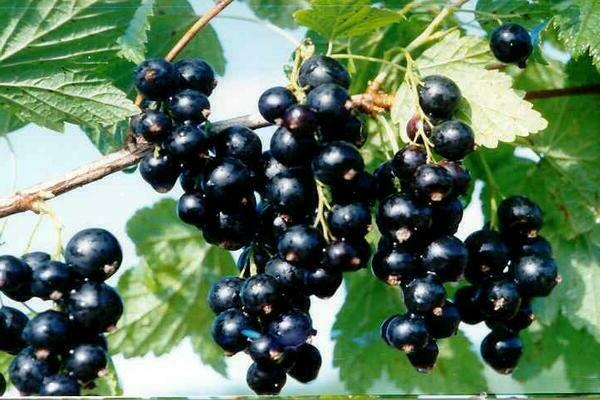
Medium early, self-fertile variety for technical use. Bred by FGBNU NIIS Siberia named after V.I. Lisavenko, suitable for growing in the Central Volga, West Siberian and East Siberian regions.
The mass of berries harvested from one plant is 3.5 kg (more than 100 c / ha), the berries are slightly elongated, the color is dark brown. The number of berries on a short brush is 5-6, the weight of one berry is up to 1.6 g. Taste characteristics are average, there is sourness. The harvest of this variety tolerates transportation calmly.
The bush is compact, slightly spreading, stems are large in diameter, grows vertically. The leaves are not large, green.
The variety is resistant to low temperature conditions and moderately resistant to lack of watering, as well as septoria and anthracnose.
"Sevchanka"
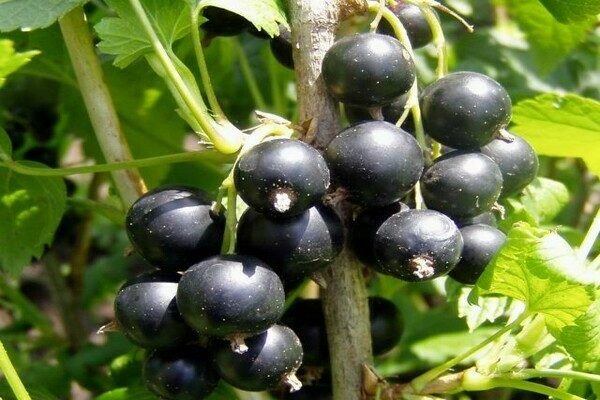
An early, self-fertile variety with a wide range of uses. Bred by FSBSI All-Russian Scientific Research Institute of Lupine. Recommendations for the place of cultivation - Central, Volgo-Vyatka and Central black earth regions.
The mass of berries harvested from one plant is 3.8 kg (more than 103 c / ha), the berries are round, black, glossy, elastic skin. On an average length of a tassel 6-7 pieces ripen, the weight of each specimen reaches 3.5 g. The berries have a good taste, a distinctive feature - there is no tendency to sprinkle when ripe.
The bush is high, slightly spreading. Stems of medium diameter, vertical. Leaves are not large, dark green.
A representative of a highly resistant currant variety to negative temperatures (including return frosts), dryness, as well as diseases such as powdery mildew, anthracnose and rust.
"Lazy person"
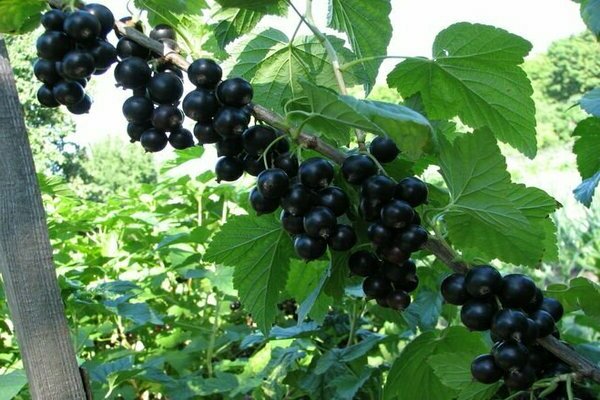
The late variety Lazybear has a wide range of uses. Originator - FGBNU All-Russian Research Institute of Breeding of Fruit Crops. Grows well in the North-West, Central, Volgo-Vyatka, Middle Volga and Ural regions.
The mass of berries harvested from one plant is 3.9 kg (more than 110 c / ha), berries are dark brown in color, there are 8-9 of them on each brush, and the weight of one specimen can reach 3.2 g. Berries of excellent taste, sweet.
The bush is tall, slightly spreading. Stems are large in diameter, vertical. The leaves are large, green.
The variety is highly resistant to low temperatures, lack of moisture, as well as powdery mildew and anthracnose.
"Pygmy"
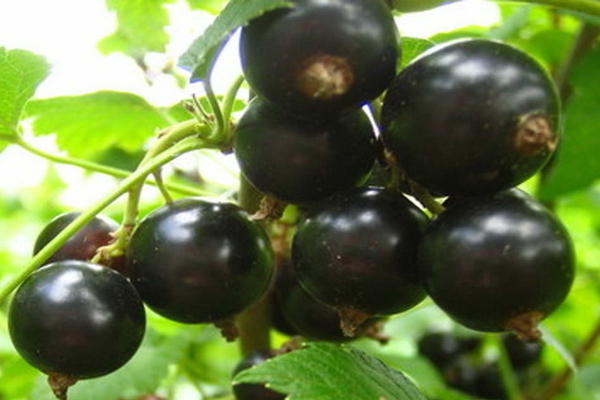
Mid-season, self-fertile, versatile Pygmy variety... Bred by FSBSI South Ural Research Institute of Horticulture and Potato Growing. Recommendations for the area of cultivation - Volgo-Vyatka, Ural, West Siberian, East Siberian and Far Eastern regions.
The mass of berries harvested from one plant is 3.8 kg (more than 108 c / ha), the berries are round, the color is dark, glossy. The density of the skin is medium, it is torn off dry. There are 7-8 berries on one brush, the weight of each specimen is up to 2.1 g. The flavor characteristics of the berries are excellent, they have a sweet taste.
The bush is compact, slightly spreading, shoots of medium diameter, growing vertically. The bush has large green leaves.
The variety is quite resistant to negative temperatures, dryness and powdery mildew, as well as moderately resistant to anthracnose.
"Gulliver"

Early maturing, self-fertile Gulliver grade a wide range of uses with simultaneous ripening of berries. Bred by FSBSI All-Russian Scientific Research Institute of Lupine. Recommendations for the area of growth - North-West, Central and Volgo-Vyatka regions.
The mass of berries harvested from one plant is 3 kg (more than 80 c / ha), berries are round, black, glossy, medium-density skin. On a medium-sized brush, they ripen up to 6, the weight of each specimen is up to 1.7 g. The flavor characteristics of the berries are average, they tend to crack with an excess of moisture.
The bush is tall, the stems are upright, slightly curved. The leaves are large, light green.
A representative of a highly resistant currant variety to negative temperatures, anthracnose and powdery mildew.
"Gift of Smolyaninova"
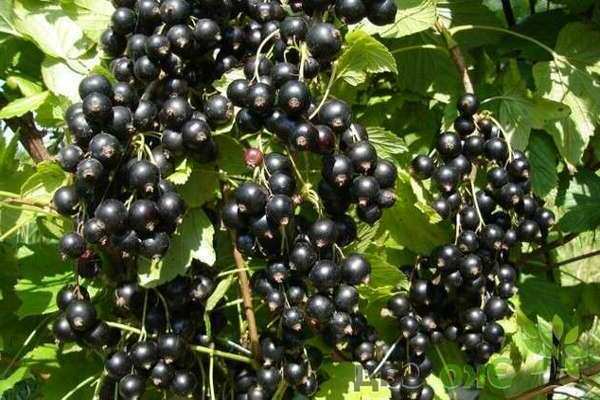
Variety Gift of Smolyaninova - a very early, self-fertile variety with a wide range of uses, with a simultaneous ripening of berries.
Bred by FSBSI All-Russian Scientific Research Institute of Lupine. Recommendations for the area of growth - Central and Volgo-Vyatka regions.
The mass of berries harvested from one plant is 3.9 kg (more than 130 c / ha), the berries are slightly elongated, the color is dark, glossy, the skin of the berries is dense, they are torn off dry. On an average brush size, 7-8 pieces ripen, the weight of one specimen is 2.8 g. The berries have wonderful taste characteristics, sweet. There is a tendency to cracking of berries with excessive rainfall.
The bush is not large, slightly spreading, shoots of medium diameter, are arranged vertically. The leaves are large, light green.
The variety is resistant to low temperatures and insufficient watering, and moderately resistant to powdery mildew and anthracnose.
"Sadko"

A mid-season, self-fertile variety for universal use. Bred by FGBNU Scientific Research Institute of Horticulture of Siberia named after V.I. M.A. Lisavenko and is intended for cultivation in the Far East region.
The mass of berries harvested from one plant is 3.7 kg (more than 105 c / ha), the berries are round, the color is black. On a medium-sized tassel, there are up to 7 berries, the weight of each instance is up to 2g. The flavor characteristics of the berries are average, there is a noticeable sourness.
The bush is tall, slightly spreading, shoots of medium diameter, growing vertically. The leaves are not large, have a light shade of green.
A representative of a highly resistant variety of currants, both to high and low temperatures, and to diseases such as powdery mildew and anthracnose.

